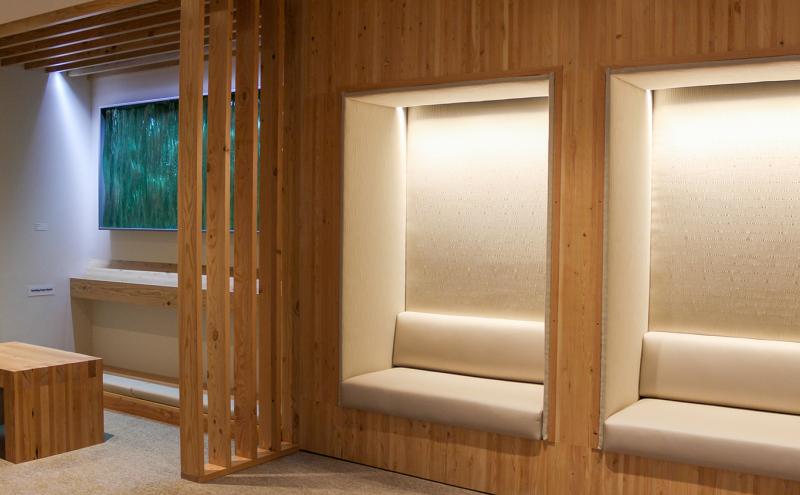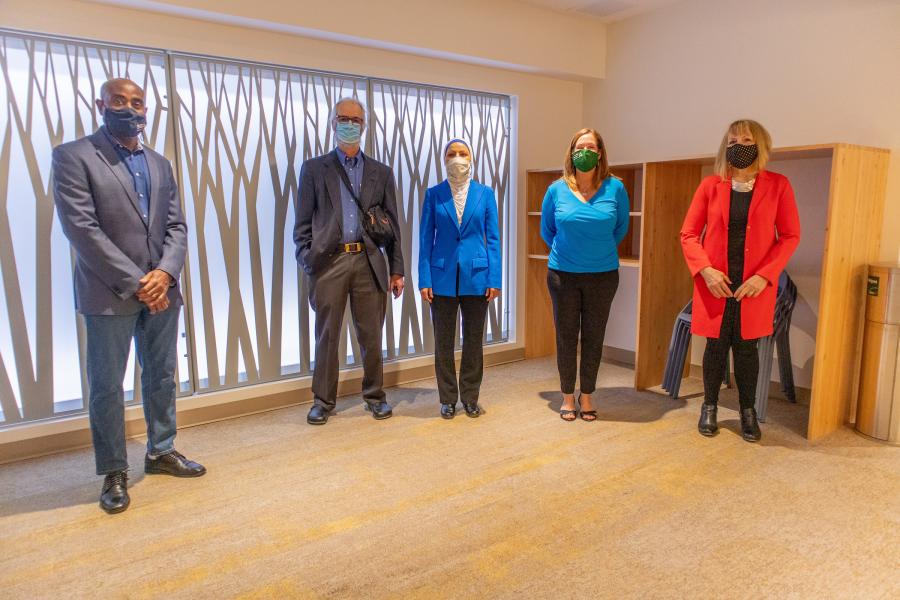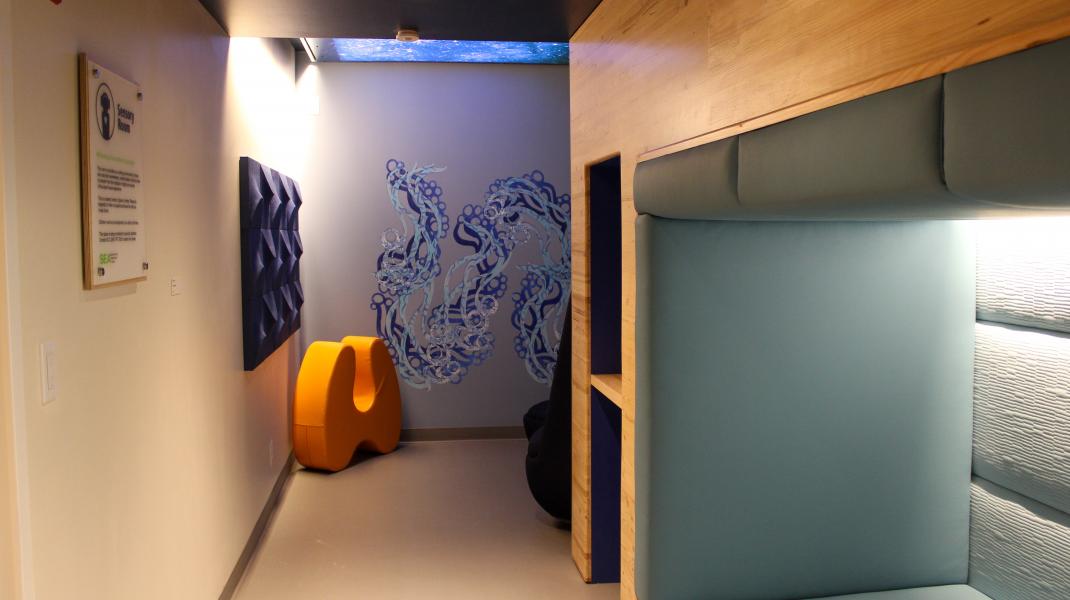
Seattle-Tacoma International Airport (SEA) today introduced unique customer amenities to better serve the airport’s diverse community of travelers. Marking World Autism Awareness Day, the airport unveiled a new Sensory Room, designed to reduce the stress of travel for those with neurological or developmental disabilities. The airport also unveiled the Interfaith Prayer and Meditation Room. The two rooms were each designed with intentional, special purposes and deep stakeholder engagement to ensure the airport is a welcoming and inclusive place for all.
The Sensory Room is a quiet area for travelers with neurological or developmental disabilities such as sensory processing disorders or autism spectrum disorders. This space is a calming environment for those who may feel overwhelmed and overstimulated or need respite from the multitude of sights and sounds of the airport. The Interfaith Prayer and Meditation Room welcomes all faiths and beliefs as an inclusive and peaceful place for meditation, worship, and reflection.
“We know there are times when travel can be challenging for people. They may have kids who need quiet time, need a peaceful place for their religious practices, or just want somewhere to go for respite,” said Port of Seattle Commissioner Stephanie Bowman. “We set an ambitious goal to be the most accessible airport in North America because it matters to us that SEA meets the needs of the people we serve. These rooms play an important role in helping us be the airport we want to be.”
Stakeholder engagement

The Sensory Room and Interfaith Prayer and Meditation Room were planned with robust and meaningful input from the community as well as research of existing, similar spaces in Seattle and other airports.
The Sensory Room at SEA is one of only a handful of airports in the U.S. that offers this amenity. Our team consulted with an occupational therapist and local leaders in the neurodiverse community for feedback in the design and construction process to incorporate caring and helpful furnishings and features. We also studied best practices from similar therapeutic spaces at Lumen Field in Seattle and airports like Miami International Airport (MIA) and Pittsburgh International Airport (PIT).
“The Sensory Room is a fantastic addition to SEA for travelers who may become overstimulated by the sounds and visual stimulation of the airport experience,” said Stacia Irons, Wings for Autism Program Manager and The Arc King County Board Member. “Having a place to go to re-center and destress before boarding a flight means the world to our community.”
The development of the Interfaith Prayer and Meditation Room invited partnership from local religious leaders representing the Buddhist, Muslim, Christian, and Jewish faiths who advised on signage, floor materials, seating, lighting, and ambiance. SEA looks forward to additional Interfaith Prayer and Meditation Rooms to the airport as part of the South Satellite renovation and future C1 Building.
“It was wonderful how religious leaders from many different traditions – Christian, Muslim, Jewish, Buddhist – harmoniously collaborated with Port officials to create this prayer and meditation space,” said Steve Wilhelm, a Buddhist practitioner and local dharma leader with Seattle Insight Meditation Society. “The result is the Interfaith Prayer and Meditation Room with features that meet the needs of people from many traditions. This new space, for the first time inside airport security, will support the contemplative needs of travelers and employees for decades to come.”
“For myself and other Muslims who have struggled to find locations to pray at airports, having a designated space that facilitates prayer is significant, from a religious accommodation perspective as well as safety, privacy, and modesty,” said Aneelah Afzali, executive director of the American Muslim Empowerment Network at the Muslim Association of Puget Sound (MAPS-AMEN). "Having a space that is shared with other faith traditions is a beautiful statement of interfaith solidarity that reminds us that even though we may pray or meditate differently, we are all one connected human family, and we have the collective humility to recognize a divine power greater than us."
Additionally, the icons to demarcate the Sensory Room and Interfaith Prayer and Meditation Room were created in consultation with our stakeholders. The sensory icon was developed through research and input with Open Doors Organization and local autism organizations to reflect love and inclusivity. The interfaith icon of hands in prayer was agreed upon by all faith stakeholders as an internationally recognized multi-faith symbol.
Sensory Room

This room creates a specialized environment for neurodiverse travelers with thoughtful lighting, furniture, and materials. Users will experience dimmable lighting, interactive furniture like seating that rocks or compresses the body, acoustic wall paneling, and graphics and materials that reflect a Northwest sense of place such as a ceiling installation of the night sky.

This year, we’re expanding existing programs and introducing improved airport experiences for all users. Things like this Sensory Room in addition to the airport’s Social Story and resource guide for travelers with autism and sunflower Lanyards for travelers with hidden disabilities.
Interfaith Prayer and Meditation Room

The aesthetics and atmosphere reflect that this is a dedicated space for meditation or prayer. Travelers will experience an open floor space to accommodate prayer with a Qibla pointer, a kneeling prayer bench, and recessed seating for individual reflection. An architectural feature of a forest is backlit with circadian rhythm to mimic the fluctuations of light throughout the day as well as dimmable overhead lighting. This room is also intended to be an honored space for airport workers to practice prayer.

Both the Sensory Room and Interfaith Prayer and Meditation Room incorporate thoughtful features like shoe and luggage storage and electrical outlets and an atmosphere that feels like the Pacific Northwest with reclaimed Douglas Fir wood from Oregon.
The Sensory Room and Interfaith Prayer and Meditation Room are located post-security, below Concourse A on the way to the STS train platform. Keep an eye out for signs that point the way, or use the interactive map or download the FlySEA App for help with wayfinding.
Contact
A b-roll reel of the Sensory Room and Interfaith Prayer and Meditation Room is available here.
Perry Cooper | SEA Airport
(206) 787-4923 | [email protected]

